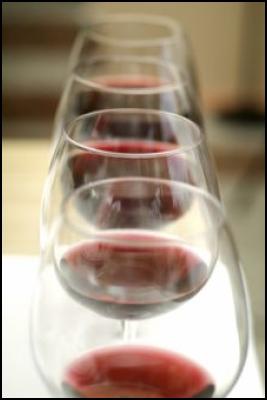Wine serving: Get the best out of your bottle
Wine serving: How to get the best out of your bottle

RELEASE
Wine serving: How to get the
best out of your bottle
Open bottle, pour wine, drink.
When it comes to serving wine, there are a few additional
steps which can enhance the tasting experience.
“The temperature wine is served at can have a profound effect on flavours and aromas,” says Alpha Domus wine expert, Paul Ham.
“The idea that red wine should be served at room temperature and whites should be cold can be very subjective.”
Paul says while champagne should definitely be served straight from the fridge, white wines, such as Alpha Domus’ barrel aged Chardonnay, are best served at 12 to 16 degrees (known as cellar temperature).
“Ice-cold wine stuns the taste buds, so we don’t appreciate the balance and complexity of flavours and aromas. To see for yourself, pour a glass of white wine straight from the fridge and taste, then leave the bottle to warm on the bench for half an hour and taste the difference.”

Paul says red wines are often served either too warm or too cold.
“As a general rule, red wines are best served comfortably above cellar temperature, but below modern room temperature at around 18 degrees. Your glass should still feel cool to the touch.”
Red wines also benefit from oxygenation, which is why you’ll see wine buffs pouring their wine into decanters.
“Red wine can become closed the longer it’s in bottle, so allowing it to breathe opens it up and releases flavours and aromas. Decanters are used because the wider surface area increases aeration.”
What you serve wine in is also important. Whether you’re serving red or white wine, the key is not to fill the glass to the brim, but rather to gently pour a small amount into the bottom of the glass, up to the widest part (about the middle).
“The idea is to swirl the wine around the bottom of the glass to release its aromas, which are then caught in the narrower part of glass at the top.”
Paul says red wine works best when served in a large glass.
“Small ISO glasses are designed for appreciating a wine’s finer qualities, but let’s be honest, it’s a whole lot more fun and festive to drink from a large glass.”
For white wine, a smaller glass with a narrower opening is ideal. This allows the aromas to come out of the wine and collect at the top of the wine glass, so you can fully appreciate them.
Dessert wines are often served in very small glasses because they are sold in smaller bottles. However, Paul says they should be served the same as white wine because they often have beautiful aromas, like the Alpha Domus Noble Selection dessert wine. It has honeyed tangelo aromas enriched with ripe mango, oriental spices, hints of smoky oak and citrus tones.
Your grandmother may well have served Champagne in a wide-mouthed glass, but the general consensus now is that anything with bubbles is much more enjoyable in a tall, thin glass.
“The narrower the mouth of the glass, the longer the bubbles stay in,” says Paul. “Flutes also allow you to see the stream of bubbles and you can tell a fine Champagne by its steady stream of small, fine bubbles.”
Paul says while the way we serve wine can improve our appreciation, there are other important factors.
“Wine always tastes better with good friends and good food - it’s a very social beverage.”
ENDS


 Canterbury Museum: Mystery Molars Lead To Discovery Of Giant Crayfish In Ancient Aotearoa New Zealand
Canterbury Museum: Mystery Molars Lead To Discovery Of Giant Crayfish In Ancient Aotearoa New Zealand Ngā Pae o te Māramatanga: Māori Concerns About Misuse Of Facial Recognition Technology Highlighted In Science
Ngā Pae o te Māramatanga: Māori Concerns About Misuse Of Facial Recognition Technology Highlighted In Science Retail NZ: Retailers Call For Flexibility On Easter Trading Hours
Retail NZ: Retailers Call For Flexibility On Easter Trading Hours WorkSafe NZ: Worker’s Six-Metre Fall Prompts Industry Call-Out
WorkSafe NZ: Worker’s Six-Metre Fall Prompts Industry Call-Out PSGR: Has MBIE Short-Circuited Good Process In Recent Government Reforms?
PSGR: Has MBIE Short-Circuited Good Process In Recent Government Reforms? The Reserve Bank of New Zealand: RBNZ’s Five Year Funding Agreement Published
The Reserve Bank of New Zealand: RBNZ’s Five Year Funding Agreement Published



